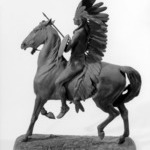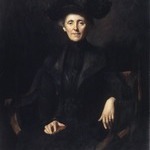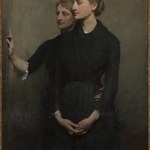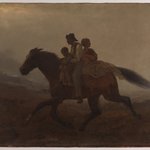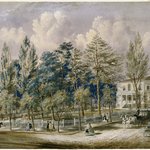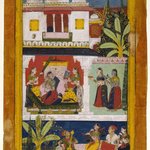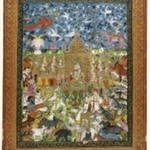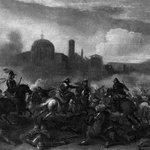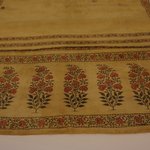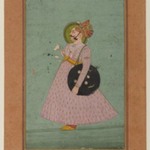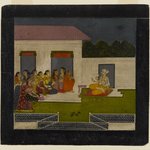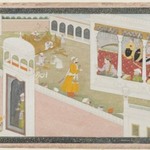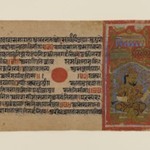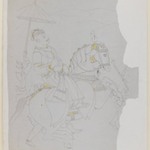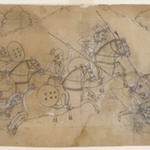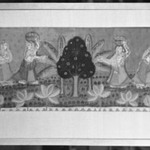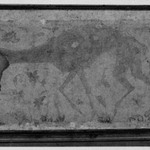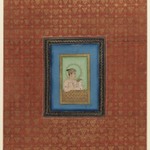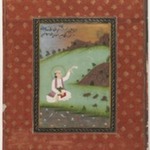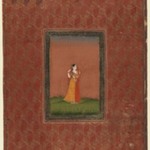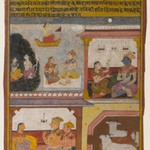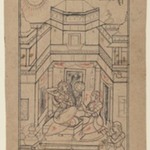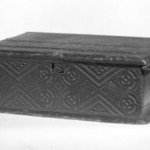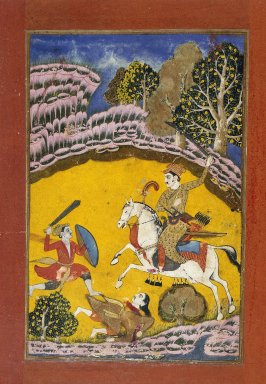
Nata Ragini, Page from a Ragamala Series
Asian Art
In the fifteenth or sixteenth century, a new genre of painting developed that attempted to capture in imagery the moods of famous passages of classical music. The music, known as ragas or raginis, inspired artists to create little scenarios—happy or sad, fierce or quiet, taking place in the daytime or nighttime, the summer or winter—that were illustrated over and over again.
The Nata musical theme is always depicted with warriors fighting. The hero, in a sumptuous golden coat and riding a fine (but strangely small) steed, easily overcomes his unmounted opponents, one of whom he has already decapitated. One of the most striking features of this painting is the highly dynamic treatment of the rocks in the background and foreground, which create a lively frame for the action. The convention of depicting rocks as swelling purple forms was borrowed by Indian artists from Persian paintings, but here the rocks are more stylized and more repetitive than one would see in Persian art.
The Nata musical theme is always depicted with warriors fighting. The hero, in a sumptuous golden coat and riding a fine (but strangely small) steed, easily overcomes his unmounted opponents, one of whom he has already decapitated. One of the most striking features of this painting is the highly dynamic treatment of the rocks in the background and foreground, which create a lively frame for the action. The convention of depicting rocks as swelling purple forms was borrowed by Indian artists from Persian paintings, but here the rocks are more stylized and more repetitive than one would see in Persian art.
CULTURE
Indian
MEDIUM
Opaque watercolor and gold on paper
GEOGRAPHICAL LOCATIONS
- Possible place made: Rajasthan, India
- Possible place made: Deccan, India
DATES
ca. 1675
DIMENSIONS
12 3/8 x 8 7/8in. (31.4 x 22.5cm)
Other: 9 3/4 x 6 3/8 in. (24.8 x 16.2 cm)
Other: 12 3/8 x 8 7/8in. (31.4 x 22.5cm)
Other: 14 1/4 x 19 1/4in. (36.2 x 48.9cm) (show scale)



COLLECTIONS
Asian Art
ACCESSION NUMBER
84.201.5
CREDIT LINE
Anonymous gift
MUSEUM LOCATION
This item is not on view
CAPTION
Indian. Nata Ragini, Page from a Ragamala Series, ca. 1675. Opaque watercolor and gold on paper, 12 3/8 x 8 7/8in. (31.4 x 22.5cm). Brooklyn Museum, Anonymous gift, 84.201.5 (Photo: Brooklyn Museum, 84.201.5_IMLS_SL2.jpg)
IMAGE
overall, 84.201.5_IMLS_SL2.jpg. Brooklyn Museum photograph
"CUR" at the beginning of an image file name means that the image was created by a curatorial staff member. These study images may be digital point-and-shoot photographs, when we don\'t yet have high-quality studio photography, or they may be scans of older negatives, slides, or photographic prints, providing historical documentation of the object.
RIGHTS STATEMENT
No known copyright restrictions
This work may be in the public domain in the United States. Works created by United States and non-United States nationals published prior to 1923 are in the public domain, subject to the terms of any applicable treaty or agreement.
You may download and use Brooklyn Museum images of this work. Please include caption information from this page and credit the Brooklyn Museum. If you need a high resolution file, please fill out our online application form (charges apply).
The Museum does not warrant that the use of this work will not infringe on the rights of third parties, such as artists or artists' heirs holding the rights to the work. It is your responsibility to determine and satisfy copyright or other use restrictions before copying, transmitting, or making other use of protected items beyond that allowed by "fair use," as such term is understood under the United States Copyright Act.
The Brooklyn Museum makes no representations or warranties with respect to the application or terms of any international agreement governing copyright protection in the United States for works created by foreign nationals.
For further information about copyright, we recommend resources at the United States Library of Congress, Cornell University, Copyright and Cultural Institutions: Guidelines for U.S. Libraries, Archives, and Museums, and Copyright Watch.
For more information about the Museum's rights project, including how rights types are assigned, please see our blog posts on copyright.
If you have any information regarding this work and rights to it, please contact copyright@brooklynmuseum.org.
RECORD COMPLETENESS
Not every record you will find here is complete. More information is available for some works than for others, and some entries have been updated more recently. Records are frequently reviewed and revised, and we welcome any additional information you might have.



